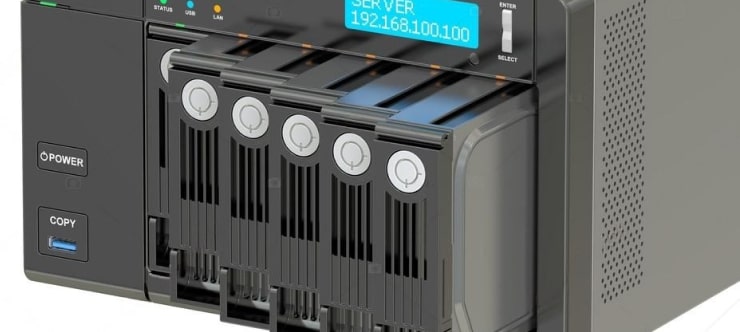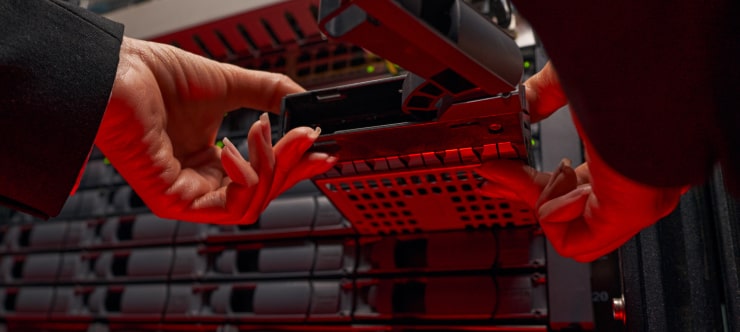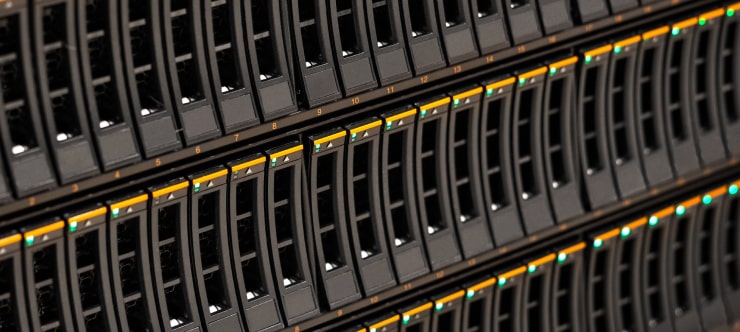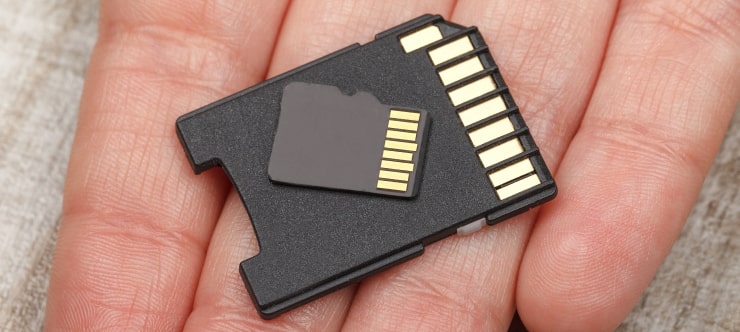NVMe vs SSD: How to Choose the Best Storage for You

I think there's an issue with my storage device, but I'm not sure
Start a free evaluationIn the world of data storage, technological advancements are a constant, and the two terms that often pop up in discussions are NVMe (Non-Volatile Memory Express) and SSD (Solid State Drive).These storage technologies have revolutionized the way we store and access data.SSDs (Solid State Drives) are storage devices that have been around for a while now, gradually phasing out traditional Hard Disk Drives (HDDs). They are called "solid-state" because they have no moving parts. Instead, they use NAND-based flash memory to store data, making them more robust, energy-efficient, and faster than HDDs.NVMe (Non-Volatile Memory Express), on the other hand, is not a type of storage device but rather a protocol designed specifically for NAND-based flash storage like SSDs. It's a communication protocol that replaces the older AHCI (Advanced Host Controller Interface) used in SSDs. NVMe is optimized for modern storage media, offering significantly faster data transfer speeds.Therefore, there are two types of SSDs: NVMe and SATA.

Speed
Speed, or data transfer rate, is a critical performance metric for SSDs. It determines how quickly data can be read from and written to the drive. Speed is often measured in megabytes per second (MB/s) and gigabytes per second (GB/s).
NVMe SSDs
NVMe drivers are known for their exceptional speed. They typically offer significantly higher read and write speeds compared to SATA SSDs. Depending on the model, NVMe SSDs can achieve read speeds exceeding 7,000 MB/s in some cases. This makes them ideal for tasks that involve moving large files quickly, such as video editing, gaming, or 3D rendering.
SATA SSDs
SATA SSDs are no slouch when it comes to speed, but they are generally limited by the SATA III interface, which caps out at around 600 MB/s.
Is NVMe faster than SSD for gaming?
When it comes to gaming, the difference in speed between NVMe and SATA SSDs is generally not significant in most scenarios. It all depends on the game you want to play, for this, you should always check the system requirements for your games.
Latency
Latency in the context of SSDs refers to the time it takes for the drive to respond to a data request. Lower latency indicates quicker response times.Latency is a critical factor for tasks that require rapid data access, such as booting your operating system, launching applications, or reading and writing small files. When choosing an SSD, consider the latency if you need rapid access to data and applications. NVMe is preferable for scenarios where every millisecond counts.
NVMe SSDs
This type of drive typically offers lower latency compared to SATA SSDs. The NVMe protocol is designed for high-speed data transfer and low latency. If you need extremely responsive storage for tasks like gaming, video editing, or database operations, NVMe SSDs are an excellent choice.
SATA SSDs
SATA SSDs also have lower latency than traditional HDDs but may have slightly higher latency than NVMe SSDs. For everyday computing tasks, the difference in latency might not be very noticeable, but it can become more apparent in demanding applications.
Form Factor
The form factor refers to the physical size and shape of the SSD. It's an important consideration because it determines whether the drive will fit into your device or system.Choosing the right form factor is crucial to ensure compatibility with your device or system. Always check your system's specifications or consult your manufacturer's documentation to confirm which form factor your system supports.SSDs come in various form factors, but the two most common ones are:
2.5-inch SATA SSDs
These are similar in size and shape to traditional hard drives (HDDs). They are commonly used in laptops and desktop computers and can often be a direct replacement for HDDs. If your system has a 2.5-inch drive bay, a 2.5-inch SATA SSD should fit without any issues.
M.2 SSDs
M.2 is a smaller and more compact form factor, resembling a small, rectangular card. These drivers are widely used in ultrabooks, compact laptops, and desktops. They connect directly to the motherboard, which reduces cable clutter and can lead to a cleaner internal setup. However, it's essential to check whether your system has an M.2 slot that supports the specific size and the key type (e.g., M.2 2280) of the SSD you plan to install.
SATA SSDs
SATA usually have the standard 2.5-inch size, which makes them compatible with most laptops and desktops.
NVMe
These drives are typically found in the M.2 form factor, which makes NVMe an excellent choice for devices with limited space and is the preferred option for many modern laptops and desktops.Can I use NVMe SSD on M.2?Yes, NVMe SSDs are often designed to be used in the M.2 form factor. M.2 is a physical interface that supports both SATA and NVMe SSDs, depending on the slot's key type and specifications on your motherboard.
Endurance
When considering the longevity of SSDs, it's important to understand the concept of SSD endurance, which refers to the lifespan of the drive in terms of data write and erase cycles.SSDs, whether they use the SATA or NVMe interface, have a finite number of write cycles before they can no longer reliably store data.
SSD SATA endurance
SATA SSDs are known for their reliability and endurance, making them a popular choice for various applications, including consumer and enterprise use. The endurance of a SATA SSD depends on factors like the NAND flash memory type and the quality of the controller and firmware. However, modern SATA SSDs often use advanced NAND technology and clever wear-leveling algorithms to extend their lifespan significantly.
SSD NVMe endurance:
NVMe, like SATA SSDs, varies in endurance depending on the components used and the intended use case. These drives have the advantage of faster data transfer speeds but still adhere to the same general principles of NAND flash endurance.NVMe SSDs can use various types of NAND flash, including SLC, MLC, and TLC. Just like with SATA SSDs, the choice of NAND type impacts endurance, with SLC being the most durable but less common in consumer NVMe drives.
Warranty
Most reputable SATA SSD manufacturers offer warranties that cover the drive for a certain number of terabytes written (TBW) or years, whichever comes first. For instance, a SATA SSD might come with a 5-year warranty and a TBW rating of 300-600 TBW, indicating the expected amount of data you can write to the drive over its warranty period.NVMe SSDs also come with warranties that specify the TBW rating and duration. These warranties can range from 3 to 5 years and have TBW ratings similar to SATA SSDs, reflecting the expected usage over the warranty period.Can SSD drives lose data?Data loss can be a devastating experience, and it can happen to anyone, including SSD users. Fortunately, there are various common symptoms of SSD failure that you can identify before permanent data loss. If needed, you can always request professional SSD data recovery services that are certified and offer a no-cost evaluation.
Price Considerations
While NVMe offers superior speed and performance, it tends to be more expensive than SATA SSDs.SATA SSDs provide a cost-effective solution for users who want a significant speed boost over HDDs but don't require the absolute top-tier performance that NVMe provides.The choice between NVMe and SSD often comes down to your specific needs and budget.
Why is NVMe more expensive than SSD?
Even though the price difference between NVMe and SATA SSDs has been narrowing as technology advances and manufacturing processes become more efficient, NVMe tends to be more expensive than SATA SSDs.
- Higher Performance: NVMe SSDs offer significantly faster data transfer speeds due to their use of PCIe lanes, advanced NAND flash technology, and optimized controllers.
- Complexity: NVMe drivers are more complex to manufacture than SATA SSDs, which can drive up production costs. The NVMe protocol also demands more sophisticated hardware.
- Market Demand: The demand for NVMe, particularly among enthusiasts, professionals, and gamers, allows manufacturers to charge a premium for their higher performance.
Overall, Is NVMe worth it over SSD?
Ultimately, the choice between NVMe and SATA SSD will depend on your specific use case and budget. For everyday computing tasks, SSDs are more than adequate. However, if you crave the fastest storage speeds available, NVMe is the way to go.In the rapidly evolving world of technology, NVMe and SSDs represent significant milestones in data storage. As we look to the future of data storage, we can expect even more exciting developments in the world of storage technology, further enhancing our computing experiences.
Related services
These are the most commonly requested data recovery services. At our headquarters' cleanroom lab, our certified engineers conduct a thorough review of any type of physical storage device, determining if there is logical or physical damage and carefully restoring all of the lost files.ces.

External Drive Data Recovery
We recover data from both external SSD and HDD drives. Rely on certified experts to restore your important files from damaged or corrupted external drives.

Hard Drive Data Recovery
Recover data from all brands of HDD, PC hard drives, and hybrid disks. Our specialists ensure fast and secure recovery for any data loss scenario.

NAS Data Recovery
Recover data from NAS devices, including RAID configurations. Our team handles all types of NAS systems and ensures data recovery with minimal downtime.

RAID Data Recovery
Our RAID data recovery services cover RAID 0, 1, 5, 10, and other configurations. We offer expert solutions for failed, degraded, or corrupted RAID arrays.

SAN Data Recovery
Our team specializes in handling SAN devices from leading manufacturers like Dell EMC, HP, and IBM, ensuring efficient recovery with minimal disruption to your operations.

SD Card Data Recovery
Our recovery experts specialize in restoring data from SD and memory cards. We guarantee quick recovery with a no-data, no-charge policy.

SSD Data Recovery
Our data recovery experts handle all SSD data loss scenarios with advanced tools, ensuring maximum recovery with high-security protocols.

USB Flash Drive Data Recovery
Recover lost data from USB flash drives, regardless of the damage or brand. We offer free in-lab evaluations to assess data recovery needs.
If you’re unsure about which data recovery service to choose, let our team assist you in selecting the appropriate solutions. We understand the anxiety that comes with a sudden drive failure, and we are more prompt in our actions compared to other recovery service providers.



